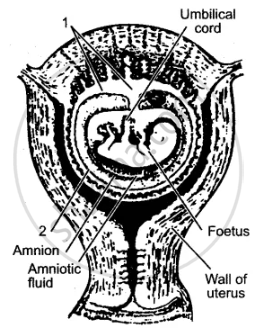Advertisements
Advertisements
प्रश्न
Give Reasons
The full-grown human embryo respires but does not breathe.
उत्तर
The full-grown human embryo respires because the dissolved oxygen in the mother’s blood diffuses into the embryo and is used in the oxidation of glucose in the cells with the liberation of energy. However there are no breathing movements as the lungs lie collapsed in the embryo and the only function after the fetus is expelled from the mother’s body. Therefore no breathing movements in the embryo as it receives oxygen by diffusion of gases.
APPEARS IN
संबंधित प्रश्न
Name and describe very briefly, the stages in the development of human embryo.
What is Placenta?
How is Placenta formed? What are its functions?
Study the diagram given below and then answer the questions that follow:

(i) Name the parts labeled 1 and 2. State the function of each part.
(ii) State any one function of the amniotic fluid.
(iii) What is the role of the umbilical cord in the development of the fetus?
(iv) Name the part in the diagram which is endocrine in nature.
Explain the term Fetus
Give Technical Term:
The part in the uterus which is concerned with the supply of nutrition from the mother to the fetus.
During pregnancy, which hormones are secreted by the placenta?
Amniotic fluid serves to provide oxygen to the foetus.
Heart and blood vessels have been formed by the end of five weeks of pregnancy.
Mother's blood flows into the foetus through placenta.
